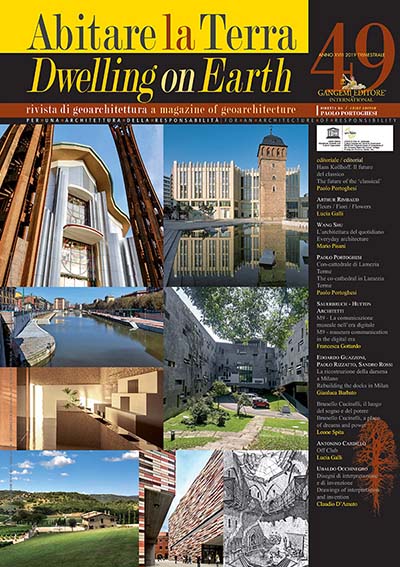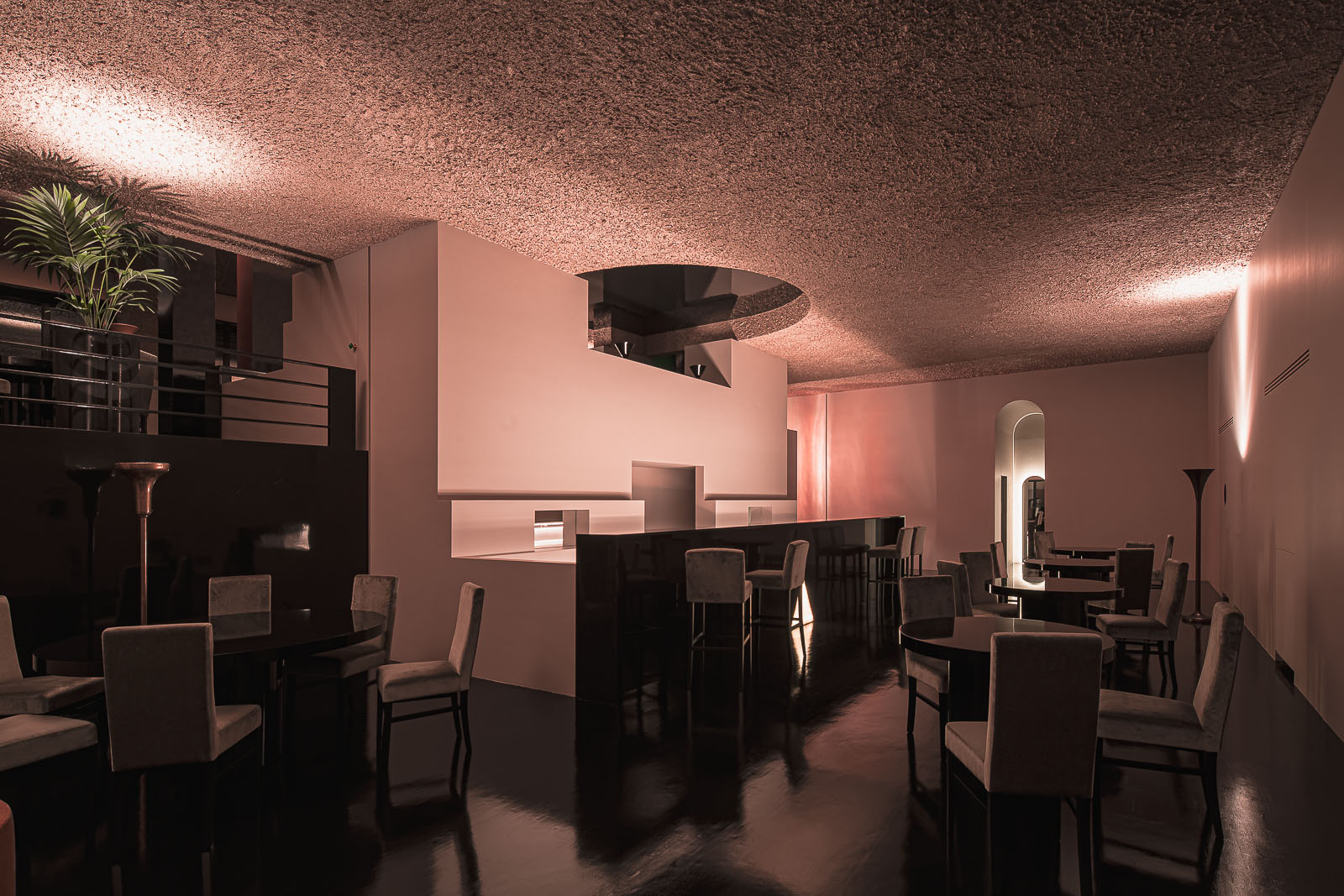
Review
Lucia Galli
The Off Club, a 400 square meter, three-floor cosmopolitan hub is the latest project by the Sicilian architect Antonino Cardillo; it was inaugurated in December 2018 in an eastern neighbourhood of Rome known as Casal Bertone.[1]
When Cardillo designed this supper club and made it a popular, recognisable venue in the city he focused on abstraction, using a pattern of citations and references to archetypes of architectural imagery that could be easily recognised by observers/spectators.
When describing the Off Club the architect himself states that he wanted to merge tactility and intuitiveness in a single environment, following up on his personal research on primordial images and Jung’s Psychologische Typen which he began even before designing the House of Dust in Rome in 2012.
The way he conjures up the tactile perception of the compositional elements is visible not only in the grainy textured ceiling[2]—almost a signature theme used in previous designs such as the aforementioned House of Dust and the Specus Corallii—but also in the floor, that looks like a pool of water, and the two massive black monoliths hollowed by elongated arches; the screen/entrance role of the arches leading to the main area of the club is emphasised by the copper coating along their internal edges.
Cardillo wished to achieve the same contrast between pattern and materials on the sandy-looking ceiling created by using coarse raw gold grains (he described it as the “vault of golden shadows”) so he inserted a shiny, reflective, enamel elliptical hollow: a “black lagoon” emphasising the core hub of the club.
The geometrically defined room around this hub has two bar areas divided by a raumplan roughly six metres high: one is a cocktail bar/mixology on the upper floor, the other is a sushi bar on the ground floor, both open on opposite sides of the club.
The service spaces—kitchens and staff area—are located in the basement, as carefully designed as the public area.
The two bar areas, with their seven-metre long, shiny black granite counters that look almost like two altars, have the same old customary form/space relationship. This perception is enhanced by the two monoliths ideally replacing the structure between the presbytery and the nave in ecclesiastical architecture (iconostasis); the openings in the monoliths also perspectively cut through the central hub of the club.
This is a strong reference to the archetype, one which is considered as the need to return to the origin of things, to a certain architectural element, free from later interpretations and restored as a container of common knowledge.
Cardillo’s objective is to “reconcile ancient and modern syntaxes” and underscore the design symmetry by figuratively using several symbols—arches, rhombi, triangles and discs—and thus conjuring up a mysterious dimension.
The two monoliths filter the interpretation of these symbols in the entrance hall; my personal opinion is that their shape recalls the metaphysical suggestions present in works by De Chirico.
The Off Club project is packed with citations and references: Cardillo himself cites films by Kubrick and De Palma, the Art Deco neighbourhood in Miami, Escher’s optical illusions, the iconostasis in Byzantine churches, and Japanese screens.
This alternation of illusion and reality reveals the profile of the designer who, as stated on the web, is acknowledged to be “one of the best Italian architects, perhaps one of the best in the world”, and also “an architect who has quite rightly gained the attention of international critics”, so much so that the London-based magazine Wallpaper*, has included him amongst the top most important young architects in the world.
These statements are intriguing, but belong to the spectacularisation of architecture and other fields. Let’s start at the beginning in 2007 the magazine The Cool Hunter published the design of the Ellipse House by architect Cardillo, and in 2010 the magazine H.O.M.E. dedicated a long article to his House of Convexities; both articles implied that these works had actually been built.
Cardillo had previously published a series of projects as imaginary architectures: ‘Houses for No One’[3] designed between 2007 and 2011; their photorealistic rendering was such that they could be mistaken for built houses. Since the journalists did not perform a thorough check, the renderings were taken to be images of real architectures.
This triggered a journalistic scandal (see Der Spiegel, n. 27/2012) and a debate in Germany and Italy about the relationship between image and construction; subsequently an interpretation was proposed and confirmed, i.e., that the images emphasised, on the one hand, the power of the artist to break the rules established in the name of art[4] and, on the other, that it was impossible for a young architect without any experience to gain the visibility needed to obtain commissions.
In actual fact, as far back as April 2010 Cardillo had been commissioned—thanks to the magazine Wallpaper*—the design of the “Sergio Rossi” shop in Milan and, in 2012, the House of Dust displayed at the XXI Triennale in Milan.
If truth be told, his ability to turn a game of illusion into reality is one of the triggers that set Antonino Cardillo on a path to success.

Antonino Cardillo, Off Club, Rome, 2018. Photography: Antonino Cardillo
Notes
- He graduated at the University of Palermo and has lectured at the Architectural Association and Royal College of Art in London; his works have been displayed at the Sir John Soane’s Museum, the German Museum of Architecture in Frankfurt, and the Triennale in Milan.
- Obtained by mixing lime, sand and pozzolana powder.
- Seven projects are part of the ‘Houses for No One’ series: Casa 1501 Ellisse; Casa Voltata; Casa delle Convessità; Casa di Max; Casa della Luna di Cemento; Casa dei Dodici; Casa Porpora.
- In the article published in Der Spiegel (n. 27 del 2012) Cardillo explains his position: “Why should we waste an idea just because there’s no client?”—“Just consider it simply as a literary narrative, a fairytale. In which it isn’t important whether or not events really take place. What’s important is to let an idea see the light. And it worked, in the meantime I was given several commissions.”